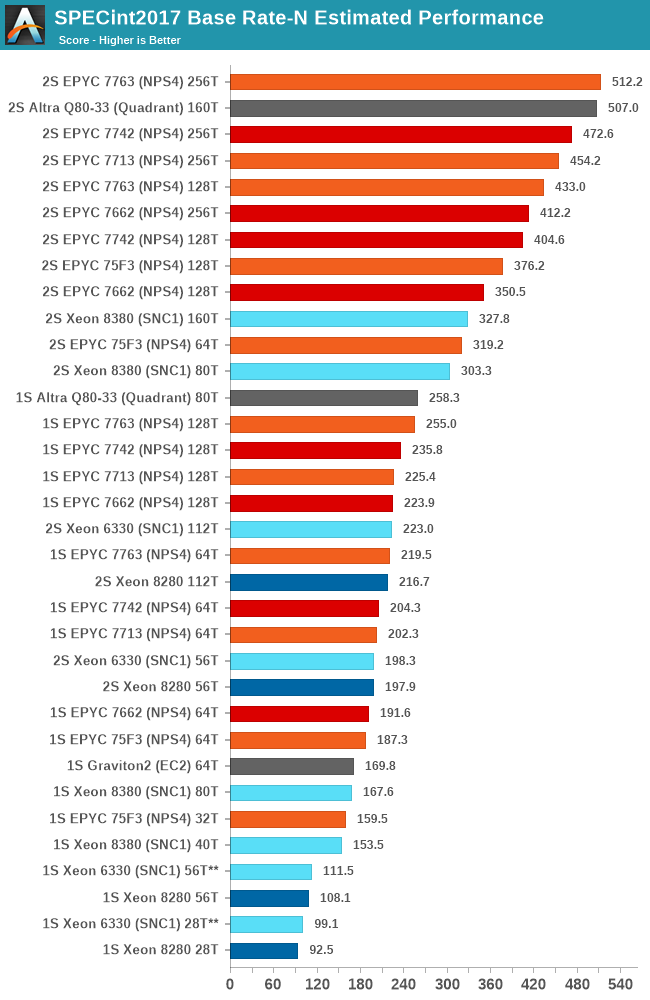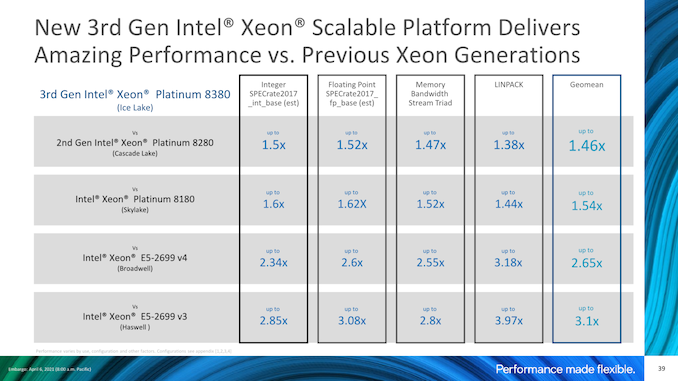Intel 3rd Gen Xeon Scalable (Ice Lake SP) Review: Generationally Big, Competitively Small
by Andrei Frumusanu on April 6, 2021 11:00 AM EST- Posted in
- Servers
- CPUs
- Intel
- Xeon
- Enterprise
- Xeon Scalable
- Ice Lake-SP
SPEC - Multi-Threaded Performance
Picking up from the power efficiency discussion, let’s dive directly into the multi-threaded SPEC results. As usual, because these are not officially submitted scores to SPEC, we’re labelling the results as “estimates” as per the SPEC rules and license.
We compile the binaries with GCC 10.2 on their respective platforms, with simple -Ofast optimisation flags and relevant architecture and machine tuning flags (-march/-mtune=Neoverse-n1 ; -march/-mtune=skylake-avx512 ; -march/-mtune=znver2 (for Zen3 as well due to GCC 10.2 not having znver3).
The new Ice Lake SP parts are using the -march/-mtune=icelake-server target. It’s to be noted that I briefly tested the system with the Skylake binaries, with little differences within margin of error.
I’m limiting the detailed comparison data to the flagship SKUs, to indicate peak performance of each platform. For that reason it’s not exactly as much an architectural comparison as it’s more of a top SKU comparison.

To not large surprise, the Xeon 8380 is posting very impressive performance advancements compared to the Xeon 8280, with large increases across the board for all workloads. The geo-mean increase is +54% with a low of +40% up to a high of +71%.
It’s to be noted that while the new Ice Lake system is a major generational boost, it’s nowhere near enough to catch up with the performance of the AMD Milan or Rome, or Ampere’s Altra when it comes to total throughput.

Looking at the FP suite, we have more workloads that are purely memory performance bound, and the Ice Lake Xeon 8380 again is posting significant performance increases compared to its predecessor, with a geo-mean of +53% with a range of +41% to +64%.
In some of the workloads, the new Xeon now catches up and is on par with AMD’s EPYC 7763 due to the fact that both systems have the same memory configuration with 8-channel DDR4-3200.
In any other workloads that requires more CPU compute power, the Xeon doesn’t hold up nearly as well, falling behind the competition by significant margins.

In the aggregate geomean scores, we’re seeing again that the new Xeon 8380 allows Intel to significantly reposition itself in the performance charts. Unfortunately, this is only enough to match the lower core count SKUs from the competition, as AMD and Ampere are still well ahead by massive leads – although admittedly the gap isn’t as embarrassing as it was before.

In the floating-point suite, the results are a bit more in favour for the Xeon 8380 compared to the integer suite, as the memory performance is weighed more into the total contribution of the total performance. It’s still not enough to beat the AMD and Ampere parts, but it’s much more competitive than it was before.
The Xeon 6330 is showcasing minor performance improvements over the 8280 and its cheaper equivalent the 6258R, but at least comes at half the cost – so while performance isn’t very impressive, the performance / $ might be more competitive.
Our performance results match Intel’s own marketing materials when it comes to the generational gains, actually even surpassing Intel’s figures by a few percent.
If you would be looking at Intel’s slide above, you could be extremely enthusiastic about Intel’s new generation, as indeed the performance improvements are extremely large compared to a Cascade Lake system.
As impressive as those generational numbers are, they really only help to somewhat narrow the Grand Canyon sized competitive performance gap we’ve had to date, and the 40-core Xeon 8380 still loses out to a 32-core Milan, and from a performance / price comparison, even a premium 75F3 costs 40% less than the Xeon 8380. Lower SKUs in the Ice Lake line-up would probably fare better in perf/$, however would also just lower the performance to an even worse competitive positioning.











169 Comments
View All Comments
fallaha56 - Tuesday, April 6, 2021 - link
surebut when your 64-core part virtually beats Intel's dual socket 32-core part on performance alone?
add the energy savings and suddenly it's a 300-400% perf lead
Jorgp2 - Tuesday, April 6, 2021 - link
The fuck?You do realize that they put more than CPUs onto servers right?
Andrei Frumusanu - Tuesday, April 6, 2021 - link
We are testing non-production server configurations, all with varying hardware, PSUs, and other setup differences. Socket comparisons remain relatively static between systems.edzieba - Tuesday, April 6, 2021 - link
Would be interesting to pit the 4309 (or 5315) against the Rocket Lake octacores. Yes, it's a very different platform aimed at a different market, but it would be interesting to see what a hypothetical '10nm Sunny Cove consumer desktop' could have resembled compared to what Rocket Lake's Sunny Cove delivered on 14nm.Jorgp2 - Tuesday, April 6, 2021 - link
You could also compare it to the 10900x, which is an existing AVX-512 CPU with large L2 caches.Holliday75 - Tuesday, April 6, 2021 - link
Typical consumer workloads the RL will be better. For typical server workloads the IL will be better. That is the gist of what would be said.ricebunny - Tuesday, April 6, 2021 - link
These tests are not entirely representative of real world use cases. For open source software, the icc compiler should always be the first choice for Intel chips. The fact that Intel provides such a compiler for free and AMD doesn’t is a perk that you get with owning Intel. It would be foolish not to take advantage of it.Andrei Frumusanu - Tuesday, April 6, 2021 - link
AMD provides AOCC and there's nothing stopping you from running ICC on AMD either. The relative positioning in that scenario doesn't change, and GCC is the industry standard in that regard in the real world.ricebunny - Tuesday, April 6, 2021 - link
Thanks for your reply. I was speaking from my experience in HPC: I’ve never compiled code that I intended to run on Intel architectures with anything but icc, except when the environment did not provide me such liberty, which was rare.If I were to run the benchmarks, I would build them with the most optimal settings for each architecture using their respective optimizing compilers. I would also make sure that I am using optimized libraries, e.g. Intel MKL and not Open BLAS for Intel architecture, etc.
Wilco1 - Tuesday, April 6, 2021 - link
And I could optimize benchmarks using hand crafted optimal inner loops in assembler. It's possible to double the SPEC score that way. By using such optimized code on a slow CPU, it can *appear* to beat a much faster CPU. And what does that prove exactly? How good one is at cheating?If we want to compare different CPUs then the only fair option is to use identical compilers and options like AnandTech does.